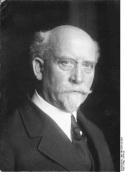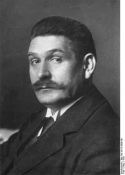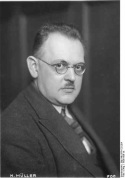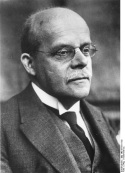Chancellor of the Reich
In the Weimar Republic, the head of government was referred to as Reichskanzler (Chancellor of the Reich). Originally, “Reichsministerpräsident” (Minister-President of the Reich) was to be used, symbolizing the Reichsministerpräsident's authority being equal to that of the federal states’ minister-presidents. Yet this title never caught on. “Reichskanzler” had already been common currency in the Kaiserreich and by August 1919, it had already regained the upper hand. In the midst of the era’s political turmoil, one incumbent followed fast on the heels of the previous one, particularly in light of the post’s considerable weakness in comparison to today’s chancellors - and to the Reichspräsident in particular.
Wikipedia entry

(© Bundesarchiv, Bild 146-1979-122-29A / o. Ang.)
1865-1939
- People’s Representative during the November Revolution
- Reichsministerpräsident (Reichskanzler) in 1919
- Mayor of Kassel

(© Bundesarchiv, Bild 183-J0113-0500-001 / o. Ang.)
1870-1944
- State Secretary in the last imperial government
- Reichskanzler from 1919 to 1920
- Minister in Scheidemann’s and Müller’s cabinets

(© Bundesarchiv, Bild 146-1979-122-28A / o. Ang.)
1876-1931
- Foreign Minister from 1919 to 1920
- Reichskanzler in 1920 and from 1928 to 1930
- Chairman of the SPD and its group in the Reichstag

(© Bundesarchiv, Bild 146-2007-0187 / o. Ang.)
1852-1926
- Elected President of the Reichstag in 1918
- Elected President of the National Assembly in 1919
- Reichskanzler from 1920 to 1921

(© Bundesarchiv, Bild 146III-105 / o. Ang.)
1879-1956
- Finance Minister from 1920 to 1921
- Reichskanzler from 1921 to 1922
- Vociferous opponent of National Socialism

(© Bundesarchiv, Bild 183-2002-0625-505 / o. Ang.)
1876-1933
- Head of the shipping company HAPAG
- Reichskanzler from 1922 to 1923
- Not able to stop hyperinflation

(© Archiv des Liberalismus)
1878-1929
- Co-founder of the German People’s Party
- Reichskanzler in crisis-ridden 1923
- Foreign Minister and Noble Peace Prize laureate

(© Bundesarchiv, Bild 183-1989-0630-504 / o. Ang.)
1885-1970
- Member of the Reichstag
- Head of the Center Party’s parliamentary group
- Reichskanzler from 1930 to 1932

(© Bundesarchiv, Bild 146-1973-011-02 / o. Ang.)
1863-1946
- Member of the National Assembly and the Reichstag
- Head of the Center Party’s parliamentary group
- Chairman of the Center Party
- Reichskanzler from 1923 to 1924 and 1926 to 1928
- Minister-President of Prussia from February to March 1925

(© Bundesarchiv, Bild 102-13534 / Foto: Georg Pahl)
1879-1969
- German officer, last rank: Lieutenant Colonel
- Military attaché in Washington from 1913 to 1915
- Became Reichskanzler in 1932
- Paved the way for Adolf Hitler

(© Bundesarchiv, Bild 136-B0228 / Foto: Tellgmann)
1882-1934
- German officer, last rank: General of the Infantry
- Reichskanzler from 1932 to 1933














